read
Two big questions you should ask:
This seems simple, but is it really an upgrade?
What about your current Google smart shopping campaigns?
Let's take a deep dive into the new campaigns and answer these questions for you.
What are Performance Max campaigns?
Performance Max is a new campaign type focused on goals. This allows advertisers to access and manage all their Google Ads inventory from a single campaign.
Let's break that down into a few easy points:
The new campaigns focus on goals. Advertisers can choose goals for their Google Ads campaigns. Machine learning will improve the goal achievement results as the campaign runs.
Advertisers can use many creative assets in a single campaign. To maximise campaign performance, advertisers will use multiple assets. These will be combined in ads across the Google Search Network and Google Display Network including Gmail and YouTube. Automation and machine learning algorithms test the results of the combinations.
These campaigns provide a single point of management for ads. These campaigns will provide a single place to manage multiple asset groups, locations, and audiences. Advertisers can oversee one campaign targeting all of Google's advertising channels.
Performance max campaigns don't replace all other ads. Instead, marketers can use them as a complement to existing campaigns. You can use one campaign to find more converting customers on channels such as YouTube, Display, Search, Discover, Gmail, and Maps.
What are the benefits of Performance Max?

Clearly Define Your Market and Competitors
This automated campaign type can conserve ad spend, increase lead generation, and boost existing search campaigns. There are four key benefits of adding Performance Max to your ad schedule.
1. Optimise Campaigns Faster
Google's machine learning makes optimization easier. You can input campaign goals, audience signals, conversion value, and budget. The algorithm will work to boost your results. As it tests assets, audiences, and channels, the machine learning system will improve the results that matter for your business.
2. Target New Audiences
Google incorporated features from their Smart Shopping and Local campaigns. The algorithm uses its real-time knowledge of consumer behaviour, intent, and preferences to target new audiences. This brings your ads to the right people at the right time.
3. Relevant Data Insights
Google is improving the reporting of Performance Max campaigns. Now, after you create ads and run them, you will see more data. Reports show which audience segments and asset combinations are doing the best. Search trends and demand forecast data help advertisers plan and refresh their campaigns.
4. Creative Asset Insights
The reports about asset and audience signals show which combinations are most successful. This insight helps clever advertisers continually tweak and improve their assets. Improved assets will convert at higher rates, thus creating more successful campaigns.
What are the pros and cons of Performance Max?
Performance Max campaigns have been available in beta testing and in the wild for a few months now. With more reviews and use, we can show you the pros and cons of Google’s new strategy.

When should you use Performance Max?
Performance Max is not the only campaign you should run. Instead, it replaces Google shopping campaigns and local campaigns, but not other campaigns. Advertisers will still want to run brand campaigns.
The new campaign type is best for those who:
Don’t have time nor resources to optimise individual channels.
Struggle to maximise multiple campaign types for one location.
Have a smaller budget but want to access more channels.
Can use a larger budget to discover new customer segments.
Are looking for new geo markets.
Like most advertising campaigns, a thorough PPC competitor analysis will help you target your advertising correctly.
What assets do you need for Performance Max to make it more successful?
The idea is for advertisers to supply a number of assets. Then, the algorithm will test combinations of these along with smart bidding to find the best results.
Here is what you need:
Headline: 3-5 headlines
Long headline: 1-5 long headlines
Description: 2- 5 description texts
Images: at least 1 square and one landscape image
Logo: at least 1 square logo, others are optional
YouTube video: not required, up to 5 videos of min 10 seconds
These are the minimum amounts. You can add more assets to supply the algorithm with more material. As it gains more material, you can review conversion data. Advertisers will be able to adjust their creatives to generate better results over time.
Where can Performance Max appear?
One big advantage of this new campaign type is the wide range of channels. Advertisers can use a single campaign to serve ads to everywhere covered by search campaigns, display campaigns, YouTube, Gmail, and Discovery campaigns.
What do the ads look like?
The ads will resemble previous ads. They are dynamic, meaning the ad asset combinations change based on the bid strategy of the algorithm.

Youtube
Can we exclude products from Performance Max?
In short, yes. Advertisers can select favourite products and run smart campaigns with Performance Max to highlight these products. However, if you already have traffic history or use shared GTINs, then the algorithm can choose keywords and search queries.
If you don’t have extensive traffic history or shared GTINs, then you can speed up the learning phase. Here’s what to do:
Subdivide your products right down to the item ID level. Custom labels could help you narrow down your product feed.
Eliminate any products that are low margin or have low conversion rates. These can be added later once the algorithm learns how to achieve the best results.
Go to your Performance Max campaign listing groups, expand the category, and then exclude the categories you want to avoid marketing.

It is also possible to exclude products in other ways from Google’s performance max campaigns. You could use feed rules in the Merchant Center, a supplemental feed, or a feed management platform. However, using the listing groups will eventually produce better data. So, you should still subdivide and track different listing groups.
Claim Your Free Audit to Uncover Hidden Opportunities
Performance Max vs from Smart Shopping Campaigns: what's the difference?
The key difference is the focus on goals. In Smart Shopping campaigns, the automated bidding worked for sales conversions only. Performance Max allows for multiple conversion goals and priorities.

A big application of this difference is using conversion value to affect the automated bidding. Higher value conversions will be prioritised by the algorithm.
So, setting conversion values across your products and business model will result in efficient ad spend and better results. Over time, usually at least six weeks, the algorithm adjusts its bidding strategy to maximise achieving the most valuable goals.
What ad formats are offered?
These ads run across all of Google’s channels. Thus, their format changes based on the channel they are being shown on. However, their format will match the ad formats previously found on the same platforms.
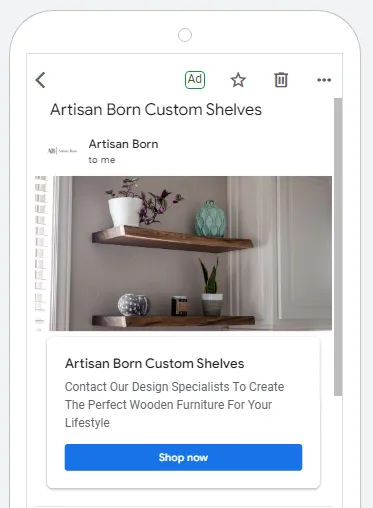
Gmail
Smart Shopping and Local campaigns will automatically upgrade to Performance Max
Google will automatically upgrade Google Smart Shopping campaigns and Local campaigns to the new ad type. The transfer will happen during two different time windows:
Smart Shopping campaigns will transition between July and September 2022.
Local campaigns will be changed between August and September 2022.
This approach may hinder some advertisers. Those who run a wide mix of ads and appreciate great control will dislike this forced changeover.
Advertisers can change to Performance Max using Google’s 1-click tool. This has been available since April 2022.
What Does Change Due to the Campaign Upgrades?
The big change is the consolidation of the different types of campaigns into the new Performance Max campaign. Google will automatically upgrade Smart Shopping and Local campaigns. The automatic process will use previous campaign data to generate the new campaigns. Historical data will remain available for analytics.
The 1-click tool from Google can upgrade all campaigns at once. However, we do not recommend this approach. Most advertisers will get better results from a phased approach.
Upgrade one campaign at a time. This slower approach gives you more control and minimises the chance of conflicts. You will also be able to adjust to the new features of Performance Max easier.
Do you still need Google Merchant Center & the feed?
Yes and no. Advertisers can run Performance Max campaigns without a Merchant Center feed. However, there are additional options and benefits for using the two together.
Performance Max can use assets and data from your feed to generate dynamic remarketing ads that can appear across the Display Network.
Product categories, product types and custom labels from your feed can be used in the new campaigns for grouping and filtering the products.
Using the two together also means you can do more optimisation. Advertisers can adjust product titles, descriptions, images, and more in the Merchant Center, and those changes automatically appear in the campaign as well
One specific change that is useful is the new short title feed attribute. This lets retailers set a shorter title for products. This will be more attractive when the ads have less space.
What type of videos work well with Performance Max?
Videos must be uploaded to YouTube to work in Performance Max campaigns, they have to be at least 10 sec in length. Beyond this rule, there is a large variety of video types that will work. There are a few tips to make these better:
Creating videos is absolutely a good idea. If you do not create videos, Google will generate some for you. However, the quality will probably not be good enough.
Building a library of video types is a smart idea. Short videos, long videos, and something in between can all be tested by the algorithms. As data comes in, you’ll see which types deliver the best performance.
In a way, this is no change. Advertisers know the value of testing different ad creatives constantly.
Can I see the search terms my products appeared for?
As of the time of writing, keyword data and usage can be problematic for Performance Max users. Here’s why:
Keyword reporting is not available at the search level. You must entirely trust Google’s algorithm to find and target the best customers.
Negative keywords cannot be added at the campaign level. This is possible at the account level. However, this is an unwieldy approach that lacks precision.
Google’s reporting and campaigns are evolving. Better reporting and targeting capabilities may be rolled out in the future.
Can I see the search terms my products appeared for?
As of the time of writing, keyword data and usage can be problematic for Performance Max users. Here’s why:
Keyword reporting is not available at the search level. You must entirely trust Google’s algorithm to find and target the best customers.
Negative keywords cannot be added at the campaign level. This is possible at the account level. However, this is an unwieldy approach that lacks precision.
Google’s reporting and campaigns are evolving. Better reporting and targeting capabilities may be rolled out in the future.
Best practices and how to make the most out of Performance Max
1. Use Full Funnel Conversion Tracking
You can add a PMax user segment to give you more details. One way to use this is to build a Google Analytics segment on the Landing Page report. This will show you where the campaign is sending

2. Create a PMax segment in Google Analytics for better reporting.
You can add a PMax user segment to give you more details. One way to use this is to build a Google Analytics segment on the Landing Page report. This will show you where the campaign is sending visitors.
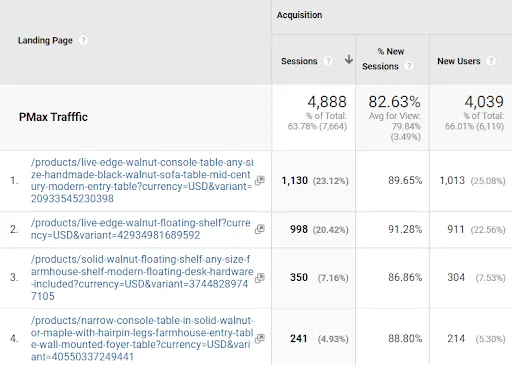
3. Watch Your URLs for Unwanted Expansion
The new campaigns can select different landing pages to send visitors to. This may be good, because it could produce extra insights. But it may also send traffic to random pages that are not effective. So you should monitor your landing page URLs.
4. Create Your Own Videos
The new campaigns are asset heavy. If you do not provide enough assets, especially video, they will be generated for you. So, be sure to create and add as many video assets as possible.
5. Watch Your Location Settings
The default setting for location preferences is “interest” rather than “presence.” If you do not change this, your ads will be shown to people who are interested in your location rather than people who are actually in your location.
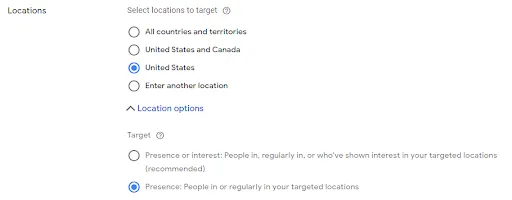
6. Target Conversions Only
As of writing, Performance Max is designed for goal-oriented campaigns such as online sales, phone calls, and specific advertising objectives. You could build an awareness campaign, but this is going against the design of the campaign.
7. Create an audience signal
The machine learning algorithm will try to target people who are most likely to convert. Instead of letting the machine run wild, create an audience signal with your remarketing list. This will start the algorithm in the right direction.
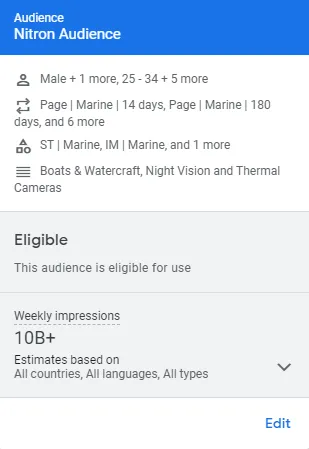
8. Review the Insights Tab
The new reports are not as clear as the previous information, especially regarding search terms. However, you can see search category reports and the audiences report. These offer clues about how relevant your ads are to converting visitors.
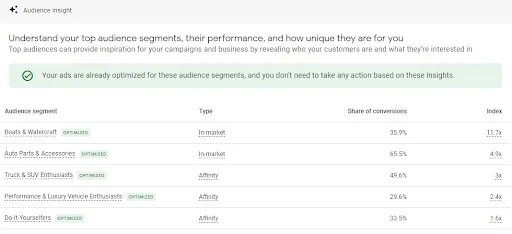
9. Don’t Copy Merchant Center Feed Images
If you are using Merchant Center, then do not duplicate product images as campaign assets. Instead of adding product images, use lifestyle images. Create good images and add them to your campaign.
10. Manage Customer Acquisition Rules
You have the option to bid only for new customers or focus on conversions. If you choose customer acquisition as the primary focus, your campaign’s performance may suffer. Converting new customers simply takes longer.
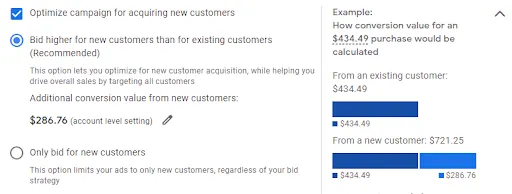
Key Takeaway
Performance Max isn't going away. Neither is machine learning. But Performance Max campaigns will perform better with a fully developed marketing plan.
Funnels, goals, and quality assets are still important. For the best results, consider working with an established digital marketing agency.


![AI Advertising in 2025: Real ROI vs Expensive Hype [Guide]](/_ipx/f_webp/img/blog/blog-ai-in-the-advertising-space.jpg)
